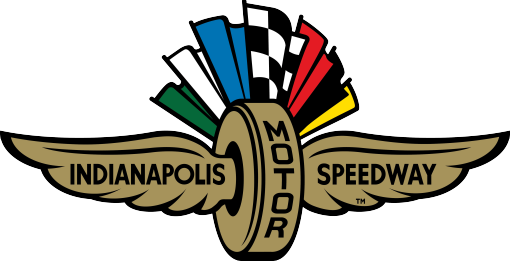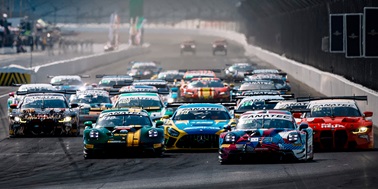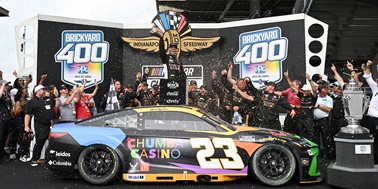He seemed too young to have achieved such a milestone, too inexperienced to have reached such a summit. Yet there he was, basking in the adulation of hundreds of thousands of people, grinning uncontrollably with fresh-faced enthusiasm and a wispy moustache.
Much time has passed since that hot August day in 1994, when Jeff Gordon was catapulted to international fame with his stunning victory at the inaugural Big Machine Vodka 400 at the Brickyard.
In retrospect, the parallels that were in play that afternoon are significant. For Gordon, that was the day when he emerged as a true superstar in the making. For NASCAR, it was another important step in its transition from a regional racing series to a worldwide motorsports force.
And it was a milestone event for the Indianapolis Motor Speedway, as it broke a decades-long pattern of racing only in May, and only with open-wheel machines.
As he stood in Victory Lane that day, Gordon was just two days past celebrating his 23rd birthday. He wore an expression that was equal parts joy and amazement, as if he was trying to come to grips with what he had just done.
The Indianapolis Motor Speedway was, in many ways, central to his destiny. He grew up in California, a child prodigy racer who rapidly progressed through the juvenile development racing series. As he approached his 13th birthday, his family prepared for the next step: wild-and-wooly sprint cars.
California racing insurers quickly decided that sprint cars and 13-year-old drivers don’t mix, so the family did some quick research and found Midwestern insurers much more accommodating. The family moved to Pittsboro, Indiana, and began the 1985 racing season in sprint cars.
Gordon was an instant phenomenon, gaining notice across the short-track racing universe. A 13-year-old in a sprint car was quite shocking at the time, and this kid was not only exceptionally young but could actually win a race now and then.
In 1988, he began his USAC Sprint Car career, and the following year made his debut in USAC Midgets. His popularity soared when he performed well in front of a nationwide audience on ESPN’s “Thunder” series, winning the 1990 USAC Midget National Championship.
The die was cast: This kid had talent, and he was headed for big places. But where?
The world of INDYCAR racing had experienced a pronounced disconnect with short-track racing during this period, and even though he was considered one of the hottest young commodities in motorsports, Gordon found open-wheel racing to be nothing but closed doors.
But with the help of longtime broadcast personality Larry Nuber and noted motorsports agent Cary Agajanian, Gordon’s career ambitions shifted to NASCAR. There he forged a relationship with successful car owner Rick Hendrick, and the destinies of both men were changed forever.
As Gordon arrived in NASCAR, the series was amid a period of great expansion. TV ratings seemed to grow exponentially, and tracks couldn’t build spectator capacity quickly enough. NASCAR was the newest, most exciting flavor on the national sports landscape, reaching deep into mainstream America. With his easy personality and impeccable image, Gordon was perfectly suited to the new environment.
A key step in NASCAR’s expansion came in April 1993, when IMS officials revealed that the famed Speedway would play host to the inaugural Brickyard 400 on Aug. 6, 1994. The 16-month lead time gave fans and competitors a long period of time to build excitement and anticipation.
When the gates swung open for pole qualifying Aug. 4, Gordon was not an overwhelming favorite. He had only won one Cup event in his career but was steadily improving. But he showed well in time trials, qualifying in the third position.
On Race Day, Gordon led early and often, but in the late stages appeared to be destined for a runner-up finish behind Ernie Irvan. The two men had dueled in the waning laps, but with 10 circuits remaining Gordon trailed Irvan and was unable to make his way back into the lead. But in a dramatic turn, Irvan cut a tire and faded, yielding the lead to Gordon with just five laps remaining.
The enormous crowd seemed to sense that history was taking place before their eyes. At one of the most anticipated events in motorsports history, a promising young racer – a young man unofficially “adopted” by Indiana – was going to win. Waving hats and programs and anything else they could clutch, the crowd rode with Gordon on those five final, fateful laps. As he cruised under the checkered flag with a half-second margin over runner-up Brett Bodine, the crowd let forth a roar that could be heard in downtown Pittsboro, some 15 miles northwest.
In a sense, that moment opened the floodgates. With Gordon’s smiling image soon adorning soda machines and magazine ads and television commercials, there was no question that NASCAR – and Gordon – had forever achieved a higher plane.
IMS officials couldn’t have hoped for a more spectacular and popular debut of their new event.
Right on cue, Gordon parlayed that powerful August victory in 1994 into a spectacular NASCAR career. He finished his NASCAR driving career in 2016 as a four-time Cup Series champion. He also won 93 Cup races, third all-time behind only Richard Petty and David Pearson.
With his victories at IMS – 1994, 1998, 2001, 2004 and 2014 – Gordon remains the only five-time winner of the Brickyard 400.




